class: center, middle, inverse, title-slide # Econ 330: Urban Economics ## Lecture 04 ### Andrew Dickinson ### 19 October, 2021 --- class: inverse, center, middle # Lecture 04: Clustering, City Size, and Growth --- class: inverse name: schedule # Schedule .pull-left[ .ul[.bigger[.hi-white[Today:]]] .hi-white[(i). Clustering] .hi-white[(ii). City size] .hi-white[(iii). Introduction to growth] ] -- .pull-right[ .ul[.bigger[.hi-white[Upcoming:]]] - .hi-white[Reading] (Chapter 3 & 4) - .hi-white[Problem set 01 due on Tuesday, October 19th] ] --- # Last Time We discussed some .hi[fundamentals] that lead to the existence of cities -- .hi-blue[Main takeaway]: Need some reason for the higher land prices within a city to be justified - Economies of scale -- .hi-blue[Questions]: .center[Why do cities grow beyond one factory?] -- .center[Why are there differences in size across cities?] -- .center[ Where do cities emerge?] --- class: inverse, middle, center # Firm clustering --- # Clustering So we explained .hi-blue[why] cities exist.. Can we explain why there might be more than one firm? -- Where to start? -- .center[.hi[Axiom 5: _Competition generates zero economic profit_]] -- Suppose a firm makes a positive economic profit. -- `\(\Rightarrow\)` additional firms enter the market -- `\(\Rightarrow \Pi \rightarrow 0\)` --- name: zero_profit # Clustering example How many firms are in the cluster? <img src="04-growth_files/figure-html/cluster_graph-1.svg" style="display: block; margin: auto;" /> --- class: inverse, middle # Data: Firm clustering --- # Clustering 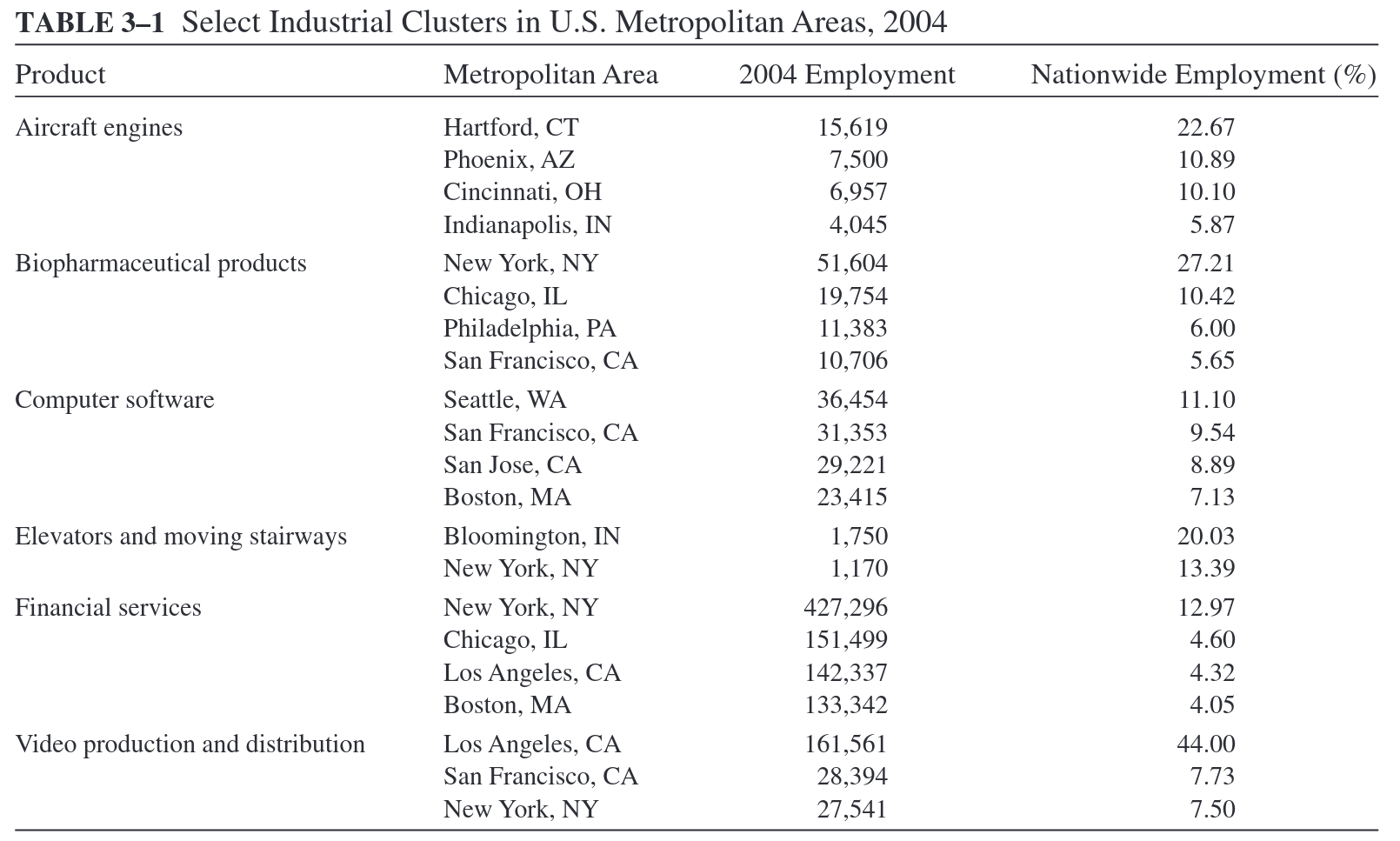 --- name: cluster # Clustering 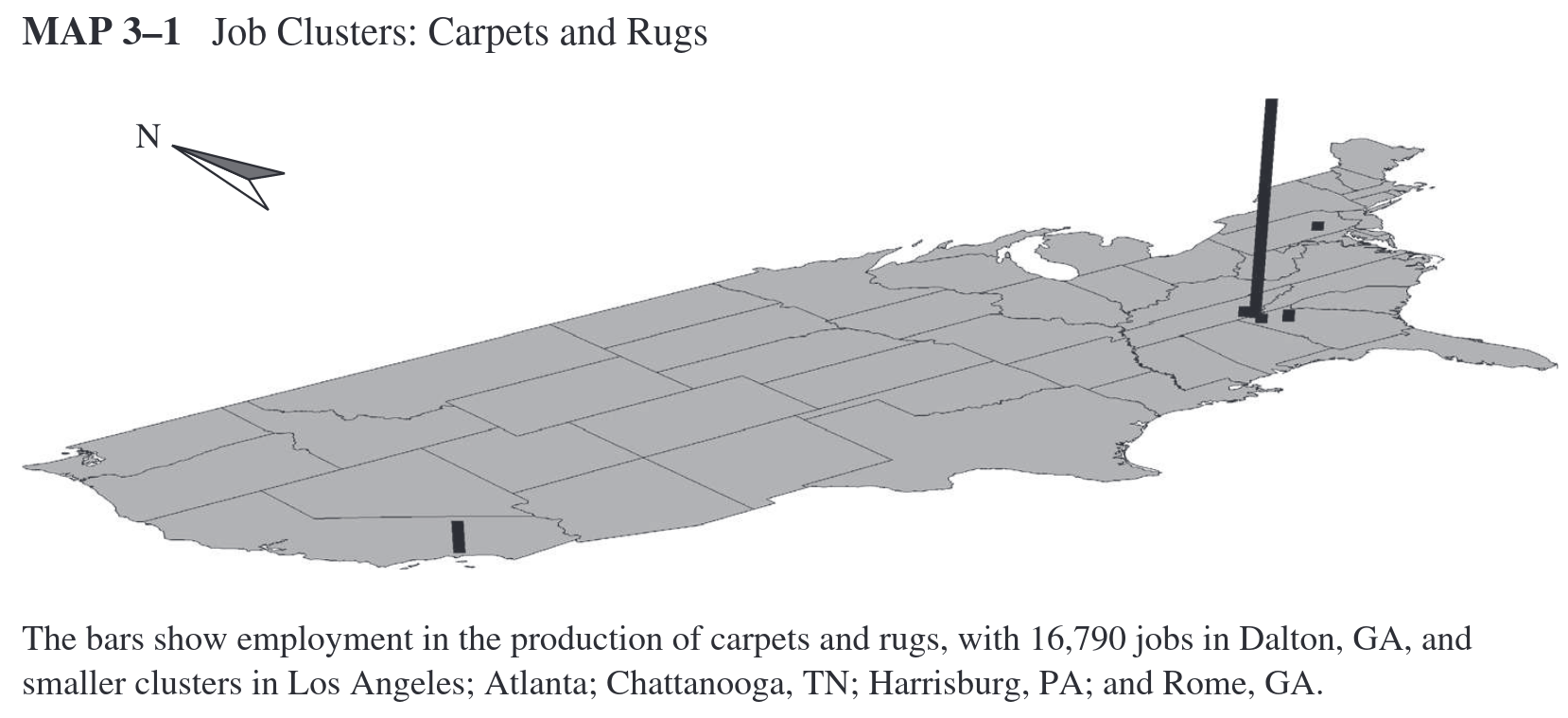 --- name: cluster # Clustering 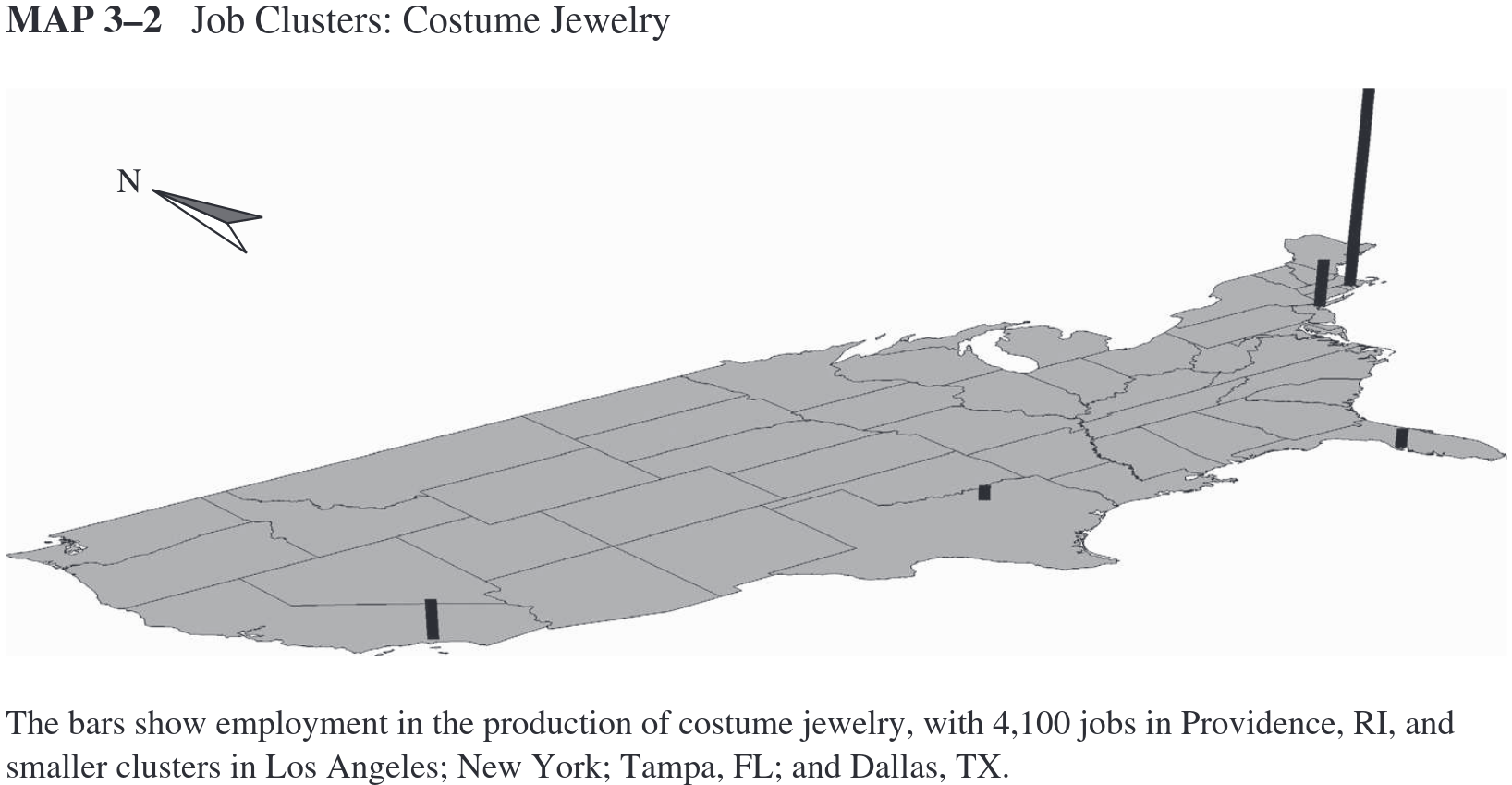 -- Which axiom do these data relate to? -- .hi[A2: Self-reinforcing effects generate extreme outcomes] --- name: cluster # Clustering Why might profit increase ( `\(\Pi \uparrow\)` ) initially as more firms .hi-orange[cluster]? -- .hi-blue[Firms may mutually benefit from clustering due to:] -- - .hi-orange[(i).] Sharing intermediate inputs - .hi-orange[(ii).] Labor matching - .hi-orange[(iii).] Knowledge spillovers - .hi-orange[(iv).] Labor pool sharing -- <br> .center[.hi-blue[Let's look at these in some more detail]] --- # (i). Sharing inputs Similar firms .hi-blue[share inputs] to benefit from economies of scale -- .hi-blue[Example:] High tech firms -- - Rapidly changing goods that require sophisticated intermediate inputs - Electronic components and testing facilities -- - Firms will share intermediate input suppliers to help reduce costs -- - Costs `\(\downarrow \quad \Rightarrow \quad \Pi \uparrow\)` -- <br> .hi-blue[Exists a optimal cluster size that maximizes the benefits of sharing inputs] --- # (ii). Labor matching In models of labor markets, we typically assume that firms and workers match perfectly -- In the real world this is rarely the case - Firms and workers are .blue[not always perfectly matched] - Mismatches .hii[require training] to eliminate skill gap. .hi[Training is costly] - Think of the training you may need for your first job -- A large city will reduce these costs --- # (ii). Labor matching Consider a labor pool of software programmers -- The skill sets of these programmers vary greatly - Coding languages: C, Javascript, Python, Rust, etc. - Programming tasks: graphics, AI/ML, OS development etc. -- Clustering .hi[attracts] more of the kind of workers they want -- Better for firm if they can find a worker to fill role immediately - Firms have higher probability in a cluster --- # (ii). Labor matching: HS model .hi[Model assumptions:] .smallererer[.hi[(i). Variation in worker skills:] Workers have a unique skill set described by an "address" on a circle] -- .smallererer[.hi[(ii). Firm entry:] Firms enter the market and pick a good with an associated skill requirement] -- .smallererer[.hi[(iii). Training costs:] Workers incur the cost associated with closing the gap on the circle between their own skill and the skill requirement to produce the good] -- .smallererer[.hi[(iv). Competition for workers:] Each firm offers a wage to anyone who meets the skill requirement; workers accept the highest net wage - Net wage `\(=\)` gross wage - training costs] -- .smallererer[Additionally, assume] - .smallererer[.hi[A4: Production is subject to economies of scale] to ensure firms hire more than one worker] - .smallererer[.hi[A5: Competition generates zero economic profit] to ensure perfect competition] --- # (ii). Labor matching: HS model .hi[Consider two cities:] .pull-left[ - City A: two firms, four workers (four skill types) ] .pull-right[ - City B: three firms, six workers (six skill types) ] -- .pull-left[ 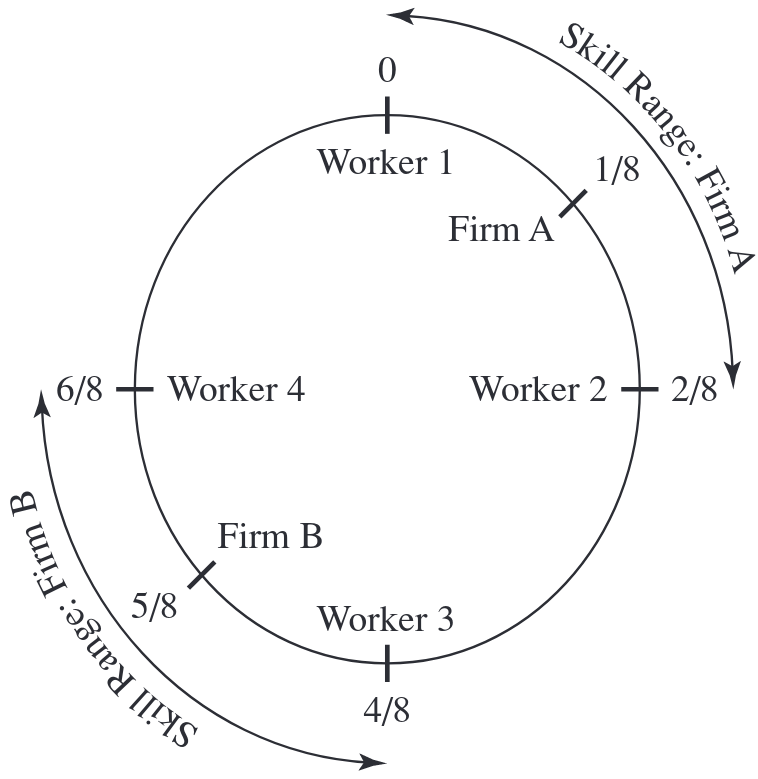 ] -- .pull-right[ 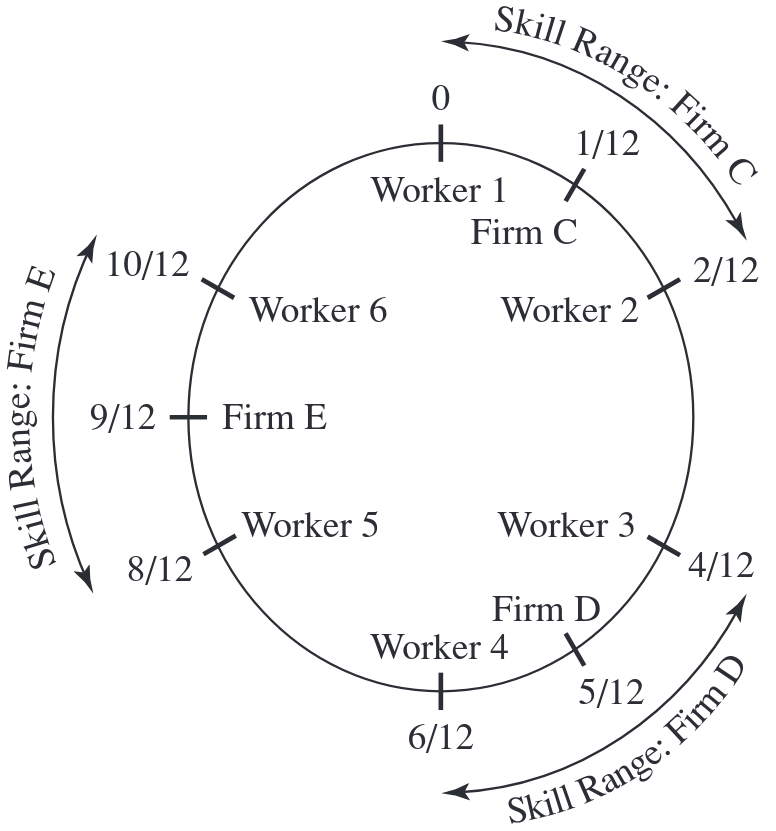 ] --- # (iii). Knowledge spillovers .hi-blue[Knowledge spillovers:] Exchange of ideas across individuals within a space -- - One of most important external benefit of a college campus (classroom) is the .hii[peer effects] -- .hi-blue[Examples:] .pull-left[ - Graduate school - Jam sessions ] .pull-right[ - Attending seminars, workshops, and conferences ] -- Knowledge spillovers increase with more people and more knowledge -- `\(\Rightarrow\)` Knowledge Spillovers `\(\uparrow\)` `\(\longrightarrow\)` Productivity `\(\uparrow\)` -- .hi-blue[Urban settings:] Silicon Valley, Wall Street, etc. --- # Agglomeration economies .ul[.hi-blue[Definition]]: .hi[Agglomeration Economies] -- - Benefits that come when firms and people locate near one another together in cities and industrial clusters -- > Agglomeration economies are the benefits that come when firms and people locate near one another together in cities and industrial clusters. These benefits all ultimately come from transport costs savings: the only real difference between a nearby firm and one across the continent is that it is easier to connect with a neighbor. Of course, transportation costs must be interpreted broadly, and they include the difficulties in exchanging goods, people, and ideas Source: [Ed. Glaeser](https://www.nber.org/chapters/c7977.pdf) --- name: urban # Agglomeration economies Let's refine our language with definitions: -- i. _.hi[Localization economies]_ - The economic forces that cause clustering that act on firms .blue[_within the same_] industry - Local to a particular industry - Example: Firms in the software industry cluster in Silicon Valley -- ii. _.hi.orange[Urbanization economies]_ - The economic forces that cause clustering that act on firms .blue[_across different_] industries - The presence of one firm attracts firms from different industries - Example: Universities; corporate headquarters --- # Localization Economies A _.hi[localization economy]_ occurs when an increase in the size of an industry leads to an increase in productivity of production .center[.hi[Why?]] -- Evidence of higher .hi[labor productivity] - Higher output `\(\rightarrow\)` more productive workers (Henderson, 1986) - Tech workers benefit more from .orange[knowledge spillovers] than manufacturing (Mun & Huchinson, 1995) -- Evidence of higher .hi[rates of entry] - More firms are born where .hii[output is higher]; that is, where the industry is clustered (Carlton, 1986) --- # Urbanization Economies _.hii[Urbanization Economies]_- the size of a city increases in productivity .center[.hi[Why?]] -- .hi[Sharing intermediate goods]: (banks, accountants, hotels, transportation) -- .hi[Pooling]: workers move from industries with low demand to high demand - .orange[across] sector -- .hi[Matching]: common skills across sectors (excel, for example) -- <br> Urbanization Economies result in .hi[large, diverse cities] --- # Examples Two major examples of .hi[localization] & .hi.orange[urbanization] economies: 1) .hi-blue[Silicon Valley] -- - .hi[Localization]: firms locate close to each other to share .orange[high-skilled labor pool] despite very high rents -- 2) .hi-blue[Los Angeles] -- - .hii[Urbanization]: No super dominant industries, yet it continues to grow --- class: inverse, middle, center # City Size --- # City Size .hi[Why are some cities big while others are small?] -- We've seen why agglomeration economies explain why .hi[firms] cluster. -- But how to agglomeration economies explain why .hii[people] cluster? -- - Agglomeration economies increase productivity and lead to higher wages in larger cities -- <br> .hi[Let's look at some data of city populations in the US] --- # City Size in the US <img src="04-growth_files/figure-html/zipf_one-1.svg" style="display: block; margin: auto;" /> -- There seems to be a functional relationship within city sizes and rank within a single country --- # What Function? f(x) = 1/x <img src="04-growth_files/figure-html/zipf_two-1.svg" style="display: block; margin: auto;" /> --- # What Function? Zipf's law <img src="04-growth_files/figure-html/zipf_three-1.svg" style="display: block; margin: auto;" /> --- name: zipf # Size: Zipf's Law .hi[Zipf's Law] of city size can be expressed as: `\begin{align*} rank = \frac{C}{N} \end{align*}` .hi[Where] - C represents a constant for a country/region - N represents the population level -- We can use the function described by Zipf's law to approximate city size based on rank --- # Zipf's Law: Example Assume the .hi[third] ( _rank_ ) largest city in a region has .hii[200,000 people] ( `\(N\)` ) - Use Zipf's law to figure out how many people are in the _fifth-largest_ city .hi[Two steps:] -- 1) Calculate the constant `\(C\)`: `\begin{align*} 3 &= \frac{C}{200,000}\\ C &= 600,000 \end{align*}` -- 2) Use that info to calculate the population of the 5th largest city: `\begin{align*} 5 &= \frac{600,000}{Pop_5} \end{align*}` --- # Zipf's Law: Example Assume the .hi[third] ( _rank_ ) largest city in a region has .hii[200,000 people] ( `\(N\)` ) - Use Zipf's law to figure out how many people are in the _fifth-largest_ city .hi[Two steps:] 1) Calculate the constant `\(C\)`: `\begin{align*} 3 &= \frac{C}{200,000}\\ C &= 600,000 \end{align*}` 2) Use that info to calculate the population of the 5th largest city: `\begin{align*} 5 &= \frac{600,000}{Pop_5} \implies Pop_5 = 120,000 \end{align*}` --- # Zipf's Law: Intuition .qa[Q]: In words, what does .hii[Zipf's law] tell us about the relationship between .hi[rank] and .hi[city size]? -- .qa[A1]: In words, this equation says: - .hi[A few] cities will be big -- - There is a .hi[big drop] in population as rank increases - Most low rank (high number) cities are .hi[pretty similar] in size --- # Example: Zipf's Law .hi[(i).] Assume that the Zipf's Law for cities is exactly true. If the .hi[fourth-largest] city in a region has .hii[2.5 million] people, how many people live in the region's .hi[largest] city? Show your work. <br> .hi[(ii).] How many people live in the region's .hi[tenth-largest] city? Show your work. --- # Primate Cities -- .hi-blue[Definition]: A .hi[primate city] is > A major city that works as the .hi[financial, political, and population center of a country] and is not rivaled in any of these aspects by any other city in that country. -- > "_at least twice as large as the next largest city and more than twice as significant."_ -- .hi[Examples]: .smallerer[ .pull-left[ .hi[City] - Seoul, South Korea - Santiago, Chile - Buenos Aires, Argentina - Lima, Peru ] ] .smallerer[ .pull-right[ .hi[Percent of Total Population] - 45.8% - 35.5% - 33.7% - 31.7% ] ] --- # Why Primate Cities? What might generate primate cities? - Large .hi[economies of scale] in exchange - Inadequate .hii[transportation infrastructure] elsewhere -- - .hi[Political factors]? -- - Easier for dictators to bribe, surveil populations of a primary city (?) - Capital cities with dictatorships are _45%_ larger than capital cities of other countries - Is this relationship .hi.orange[causal]? <sup>.orange[†]</sup> -- .footnote[ .orange[†] Maybe somebody does. But you definitely can't say from the 45% number. Much of modern econ is about figuring out when relationships _are_ causal. For a completely unrelated, but informative and entertaining example, see [this video](https://www.youtube.com/watch?v=6YrIDhaUQOE&t=133s). ] --- # Why Zipf's Law? .qa[Q]: _Why does Zipf's Law_ do pretty well in general at describing city size? -- .qa[A]: __Axiom 2__: _.hi[Self-reinforcing effects] generate extreme outcomes_ - "Winner take all" situations from policies, agglomeration, knowledge spillovers, etc. -- - Wages grow, workers in, firms enter, `\(\rightarrow\)` labor demand `\(\uparrow\)` `\(\rightarrow\)` wages grow . 🔁 -- .qa[Q]: What slows this process down? -- .center[.hi[Increases in costs lead to diseconomies of scale]] --- # Size Why do costs increase as workers move in? (Diseconomies of scale?) (i). .hi[Commute costs increase] - More people `\(\implies\)` more congestion (all else equal) -- (ii). .hi.green[Pollution] increases - More workers `\(\implies\)` more production `\(\implies\)` more .green[pollution]? -- (iii). .hii[Disease] -- - Early 1900's (US), living in a city `\(\rightarrow\)` life expectancy `\(\downarrow\)` 5 years - Now, the US's largest cities life expectancy exceeds the national average -- - Life expectancy in cities is lower than rural areas in developing economies. .hi[Why?] --- name: utility # Utility .hi[Utility] is an abstract notion of peoples preferences. A few assumptions: -- What we use to model the values individuals place on different city attributes -- .hi[(i).] Higher levels of utility are .hii[preferred] to lower levels. And more consumption is better than less .hi[(ii).] .hi[_Ordinal, not cardinal._] Only the .hii[rank] matters, not the .hii[level] -- .hi[(iii).] Marginal utility is diminishing (marginal value is diminishing) -- .center[.hi[Similar to the assumption that firms maximize profits, we also assume that individuals maximize utility]] --- # Modeling City Size <img src="04-growth_files/figure-html/u_f1-1.svg" style="display: block; margin: auto;" /> --- # Modeling City Size <img src="04-growth_files/figure-html/u_f2-1.svg" style="display: block; margin: auto;" /> --- # Modeling City Size <img src="04-growth_files/figure-html/u_f3-1.svg" style="display: block; margin: auto;" /> --- name: eq # Locational Equilibrium .hi[Locational Equilibrium] occurs when utility levels (valuations) across cities are the same for all workers -- In a system of cities, .hi[migration] has a .hii[self-correcting] effect - Locational Eq is stable when the utility curve is downward sloping - `\(\implies\)` Cities tend to be too large rather than too small -- In practice, we usually do this by .hii[worker type] (demographic, income level, education, etc) - For now, we will just consider the case when .hi[all workers are equivalent] (_but not cities_) - This assumption is mostly for accounting purposes. Best to start simple. --- # Locational Eq Graph <img src="04-growth_files/figure-html/u_loc-1.svg" style="display: block; margin: auto;" /> --- # Locational Eq: Implications Back to the .hi.orange[real world]: _Why is this framework useful?_ - If utility really has this shape, what does this mean for policy? -- _Policies that impact the .hi[spatial distribution] of the population can have far flung effects on individuals it was not designed to impact, .hii[via migration]_ .hi-blue[Example]: -- - Local school quality improvements `\(\rightarrow\)` increased prices. Higher utility from school quality, lower from higher prices. Some people may be displaced? (Gentrification) -- - Net effect could be positive, but there will be winners and losers -- More on this later in the term (.hii[place-based] policies). --- class: inverse, middle, center # Intro to Growth --- name:growth_factors # Growth .hii[Econ in General]: Defined as an increase in per-capita income .hi[Urban Economics]: Defined as an increase .hi[_utility level_] of a typical resident -- .hi[Urban definition accounts for factors other than wage.] Such as: -- .hi[(i).] Increases in natural resources (.blue[gold is found under a city]) -- .hi[(ii).] Increases in physical capital (.blue[computers] 💻) -- .hi[(iii).] Increases in human capital (.blue[education] 🎓) -- .hi[(iv).] Technological progress (.blue[computers invented]) -- .hi[(v).] Agglomeration Economies 🏙 --- name:example # Example: Innovation .pull-left[ <img src="04-growth_files/figure-html/u_innov-1.svg" style="display: block; margin: auto;" /> ] .pull-right[ Initially: 2 cities, both with same utility curve Population each city: .orange[800k] (total pop, 1.6 m)] --- # Example: Innovation .pull-left[ <img src="04-growth_files/figure-html/u_innov2-1.svg" style="display: block; margin: auto;" /> ] .pull-right[ Productivity shock brings one city's curve up (due to say, higher wages) In the absence of migration, utility is now higher in the higher productivity city] --- # Example: Innovation .pull-left[ <img src="04-growth_files/figure-html/u_innov3-1.svg" style="display: block; margin: auto;" /> ] .pull-right[ .hi[Migration] induces workers toward the more productive city and away from the less productive city - .hi.orange[New locational eq] ( `\(u^*\)` ): utility is equalized (higher than before). populations change ] -- .hi-blue[Note]: We are implicitly assuming - People are identical and perfectly mobile In real life high skilled workers are generally far more mobile than low skilled --- # Example Recap <div style="text-align: left"> Consider two cities: each with an equilibrium population of 800k and the same utility per worker curve</div> - .hi[Innovation] (tech progress) in one city .blue[shifts utility per worker] curve up -- - Workers in the innovative city enjoy a higher level of utility - Workers migrate from the city that failed to innovate -- Eventually, a new equilibrium is reached where .hi[utility per worker] is the .hi[same across both cities] - Innovative city is larger --- name:economy_wide # Economy - Wide Growth .hi[Note]: If there is an .hii[innovation for the entire economy], then .hi[both cities] experience upward shift of utility curve - Since there is no utility gap, there is .hi[no migration] -- - Still economic growth, but city sizes stay the same --- # Table of Contents .pull-left[ ### Clustering .smallest[ 1. [Reasons for Firm Clustering](#cluster) 1. [Urbanizations vs Localization](#urban) ] ### City Size .smallest[ 1. [Zipf's Law](#zipf) 1. [Utility](#utility) 1. [Locational Eq](#eq) ] ] .pull-right[ ## Growth .smallest[ 1. [Growth factors](#growth_factors) 1. [Example](#example) 1. [Economy Wide Growth](#economy_wide) ] ] --- exclude:true <!-- --- --> <!-- exclude: true --> <!-- ```{R, generate pdfs, include = F} --> <!-- system("decktape remark 02_goodsmarket_part1.html 02_goodsmarket_part1.pdf --chrome-arg=--allow-file-access-from-files") --> <!-- ``` -->